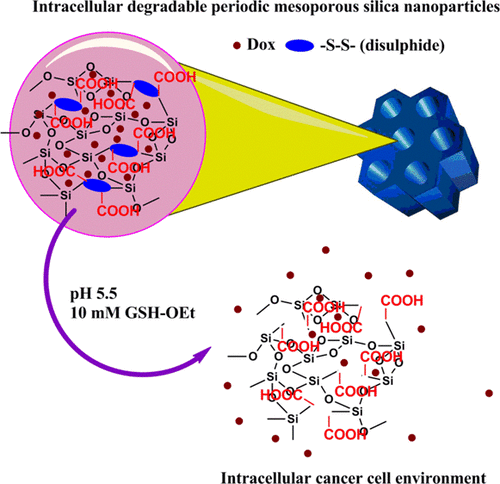当前位置:
X-MOL 学术
›
ACS Biomater. Sci. Eng.
›
论文详情
Our official English website, www.x-mol.net, welcomes your feedback! (Note: you will need to create a separate account there.)
Tunable Intracellular Degradable Periodic Mesoporous Organosilica Hybrid Nanoparticles for Doxorubicin Drug Delivery in Cancer Cells
ACS Biomaterials Science & Engineering ( IF 5.8 ) Pub Date : 2017-12-22 00:00:00 , DOI: 10.1021/acsbiomaterials.7b00558 Kummara Madhusudana Rao 1 , Surendran Parambadath 2 , Anuj Kumar 1 , Chang-Sik Ha 3 , Sung Soo Han 1
ACS Biomaterials Science & Engineering ( IF 5.8 ) Pub Date : 2017-12-22 00:00:00 , DOI: 10.1021/acsbiomaterials.7b00558 Kummara Madhusudana Rao 1 , Surendran Parambadath 2 , Anuj Kumar 1 , Chang-Sik Ha 3 , Sung Soo Han 1
Affiliation

|
In this work, a dual (pH and redox)-sensitive cystamine-integrated periodic mesoporous organosilica (Cys-PMO) hybrid nanoparticle has been developed and subsequently loaded with doxorubicin (Dox) as an anticancer drug for intracellular cancer drug delivery. The formation of Cys-PMO was confirmed by FTIR, 13C (CP-MAS), and 29Si MAS NMR spectroscopic techniques. X-ray diffraction and transmission electron microscopy confirmed that the Cys-PMO hybrid nanoparticles possessed mesoscopically ordered 2D hexagonal (P6mm) symmetry with cylindrical shape morphology. The N2 sorption isotherm showed that the Cys-PMO hybrid nanoparticles have a large surface area (691 m2 g–1), pore diameter (3.1 nm), and pore volume (0.59 cm3 g–1). As compared to conventional mesoporous silica materials and other PMO nanoparticles, the developed Cys-PMO hybrid nanoparticles have the capability of holding a high Dox content 50.6% (15.2 mg of Dox per 30 mg of Cys-PMO) at an optimized concentration (20 mg Dox) and avoid premature drug release under extracellular conditions. In vitro, the treatment of HeLa cells with Dox-encapsulated Cys-PMO hybrid nanoparticles results in a significantly greater cytotoxicity in response to intracellular acidic pH and a redox environment due to the degradation of disulfide bonds available in the framework of Cys-PMO hybrid nanoparticles. Further, confocal microscope images show the colocalization of Dox-loaded Cys-PMO hybrid nanoparticles inside the HeLa cells. Upon internalization inside HeLa Cells, the Cys-PMO use intracellular pH and redox environments to release Dox to the nucleus. Thus, the pH and reduction sensitivity of Cys-PMO hybrid nanoparticles make them suitable for intracellular drug delivery applications.
中文翻译:

可调节的细胞内可降解的周期性中孔有机硅杂化纳米粒子在癌细胞中对阿霉素的药物递送
在这项工作中,已开发出双重(pH和氧化还原)敏感的胱胺整合的周期性介孔有机二氧化硅(Cys-PMO)杂化纳米颗粒,并随后装载了阿霉素(Dox)作为抗癌药物,用于细胞内癌症药物递送。通过FTIR,13 C(CP-MAS)和29 Si MAS NMR光谱技术确认了Cys-PMO的形成。X射线衍射和透射电子显微镜证实,Cys-PMO杂化纳米粒子具有介观有序的二维六边形(P6mm)对称性,具有圆柱形状。N 2吸附等温线表明,Cys-PMO杂化纳米颗粒具有较大的表面积(691 m 2 g –1),孔径(3.1 nm)和孔体积(0.59 cm 3 g –1)。与常规的介孔二氧化硅材料和其他PMO纳米颗粒相比,开发的Cys-PMO杂化纳米颗粒能够以最佳浓度(20 mg)保持50.6%的高Dox含量(每30 mg Cys-PMO 15.2 mg Dox)。 Dox),并避免在细胞外条件下过早释放药物。在体外,由于Cys-PMO杂化纳米粒子框架中可用的二硫键降解,用Dox封装的Cys-PMO杂化纳米粒子处理HeLa细胞会导致对细胞内酸性pH和氧化还原环境产生明显更大的细胞毒性。 。此外,共聚焦显微镜图像显示了HeLa细胞内部Dox加载的Cys-PMO杂化纳米颗粒的共定位。在HeLa细胞内部化后,Cys-PMO使用细胞内pH和氧化还原环境将Dox释放到细胞核。因此,Cys-PMO杂化纳米颗粒的pH值和还原敏感性使它们适用于细胞内药物递送应用。
更新日期:2017-12-22
中文翻译:

可调节的细胞内可降解的周期性中孔有机硅杂化纳米粒子在癌细胞中对阿霉素的药物递送
在这项工作中,已开发出双重(pH和氧化还原)敏感的胱胺整合的周期性介孔有机二氧化硅(Cys-PMO)杂化纳米颗粒,并随后装载了阿霉素(Dox)作为抗癌药物,用于细胞内癌症药物递送。通过FTIR,13 C(CP-MAS)和29 Si MAS NMR光谱技术确认了Cys-PMO的形成。X射线衍射和透射电子显微镜证实,Cys-PMO杂化纳米粒子具有介观有序的二维六边形(P6mm)对称性,具有圆柱形状。N 2吸附等温线表明,Cys-PMO杂化纳米颗粒具有较大的表面积(691 m 2 g –1),孔径(3.1 nm)和孔体积(0.59 cm 3 g –1)。与常规的介孔二氧化硅材料和其他PMO纳米颗粒相比,开发的Cys-PMO杂化纳米颗粒能够以最佳浓度(20 mg)保持50.6%的高Dox含量(每30 mg Cys-PMO 15.2 mg Dox)。 Dox),并避免在细胞外条件下过早释放药物。在体外,由于Cys-PMO杂化纳米粒子框架中可用的二硫键降解,用Dox封装的Cys-PMO杂化纳米粒子处理HeLa细胞会导致对细胞内酸性pH和氧化还原环境产生明显更大的细胞毒性。 。此外,共聚焦显微镜图像显示了HeLa细胞内部Dox加载的Cys-PMO杂化纳米颗粒的共定位。在HeLa细胞内部化后,Cys-PMO使用细胞内pH和氧化还原环境将Dox释放到细胞核。因此,Cys-PMO杂化纳米颗粒的pH值和还原敏感性使它们适用于细胞内药物递送应用。


























 京公网安备 11010802027423号
京公网安备 11010802027423号